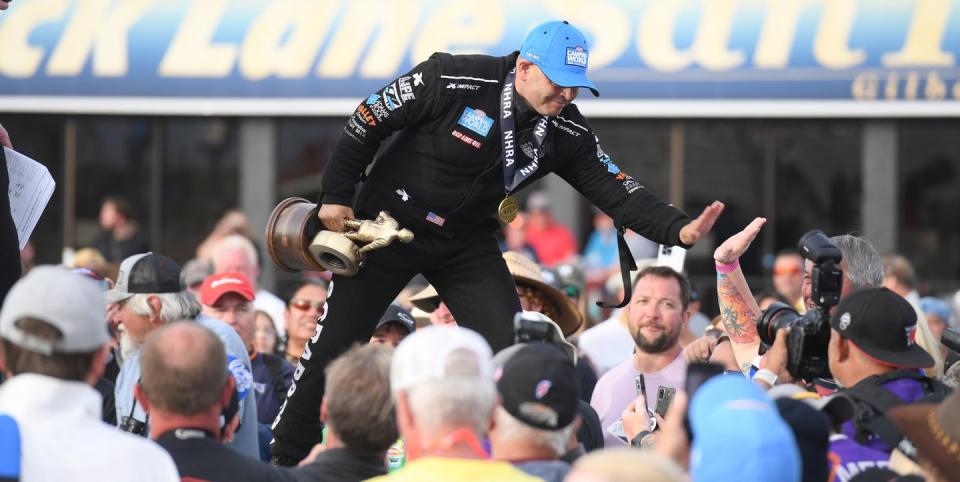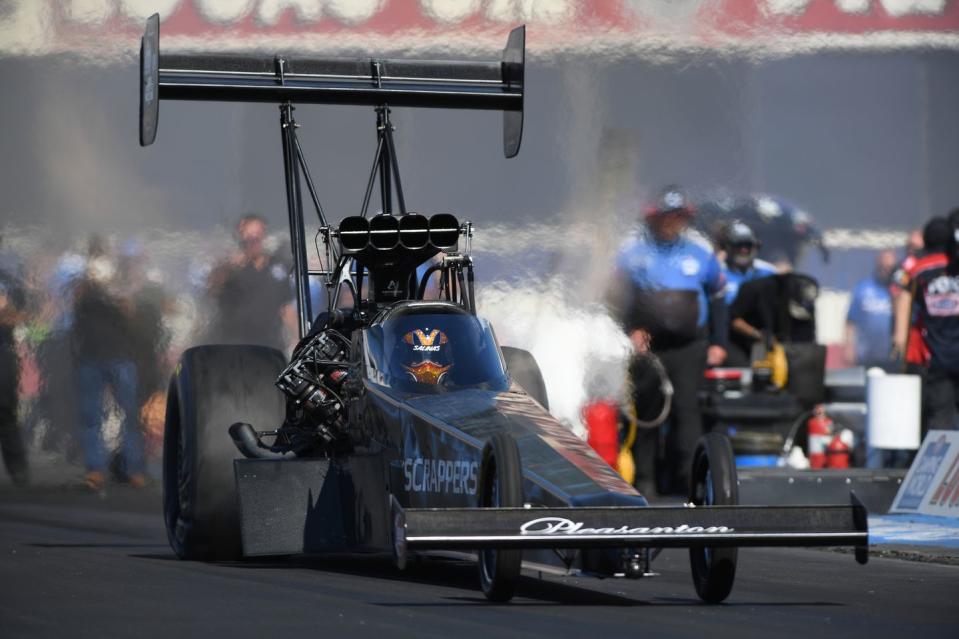Veteran Racer Mike Salinas Sounds an Alarm about the Future of the NHRA

Mike Salinas says NHRA decision-makers need to adapt to changing culture.
Promoting Jr. Dragster and Lucas Oil Series racers key to filling pipeline.
He says he would rejuvenate the sport and put people first if he were in charge.
NHRA Camping World Drag Racing Series Top Fuel owner-driver Mike Salinas developed a unique business perspective the hard way.
Salinas' strict father forced him to leave home at age 15. And even though he lived under a bridge at first (and then a shack on property he now owns), he was self-motivated to start an not-so-glamorous but lucrative niche business—collecting and hauling scrap metal—while finishing high school.
Salinas turned that scrap metal gig into a multi-corporation empire that eventually enabled him to send his wife to Harvard and their four children to a prestigious West Coast university, as well as maintain a scholarship program for his employees.
He has a successful NHRA Top Fuel operation—and a fourth career victory from this past weekend’s Arizona Nationals.
Salinas, now 60, has a few ideas as to how the sport can save itself. He’s a survivor, and he knows the sanctioning body can be, too—if it can craft the right path and be disciplined enough to follow it, like he did with his own life.
“There's not enough people looking at” some obvious facts that signal some changes—a fresh mindset, some marketing initiatives—are imperative now.
Consider:
• Don Schumacher’s once-mighty presence on-track has dwindled to one car.
• John Force Racing is back at full strength, but the Funny Car and business icon has had to pump in millions of his own personal savings in the past two years to keep his operation going – and still works at a frenetic pace to restore stability.
• Schumacher, Force, and Connie Kalitta—the sport's “Big Three” team owners for the past 20 years—have an average age of 78.
“So the sport is in trouble,” Salinas said, not so much as a complaint but more like an alarm. For the deeper thinkers in the drag-racing community, he said, “It's trying to figure out what's going to happen in this sport, where we're going to go.
"Just look around. There's a big disconnect. Look at the age group. There's no young kids here; there's very few. To sustain a culture, any culture, what does it take? That will tell you how many more years and this will be gone.
“If I had the job of running this . . . I would do it a different way."
Before anyone in the NHRA hierarchy becomes defensive, it’s vital to know that Salinas loves the sport and plans to extend his involvement. He's not planning on going anywhere. He understands that the NHRA faces challenges it didn’t cause.
For example, he said, “Think about this: One-third of our population did not have a driver's license at 35 because of Uber.”
In an effort to save, or at least grow, the NHRA, addressing a cultural shift is an appropriate place to start.

Young adults (men and women) continue to work on and be fascinated with street cars and race cars. But, Salinas said, “They're doing it in a different way. It's good. You got to respect them. They're still doing the same thing. When I was a kid, I had hopped-up cars. Well, theirs is a Honda instead of a Chevy. It’s still a car.
“But these powers that be (in the NHRA) don't see it that way. They're not replenishing young people into this sport. You got to reinvent it all the time. I would have those import guys here, racing with the little noisy cars, because those are the Top Fuel drivers of tomorrow.
“There's different cultures. It's different. So, knowing that, wouldn’t you want to try harder? Or the powers that be are 60-plus years old that in 15-to-20 years will be dead and they don't care? You need to care. My daughters are starting to run our companies. They're the new version of me, and honest to God, they're doing a better job. They see things that I don't see—the technology, electronics, everything—and they’re doing it better,” Salinas said.

 Yahoo Autos
Yahoo Autos 